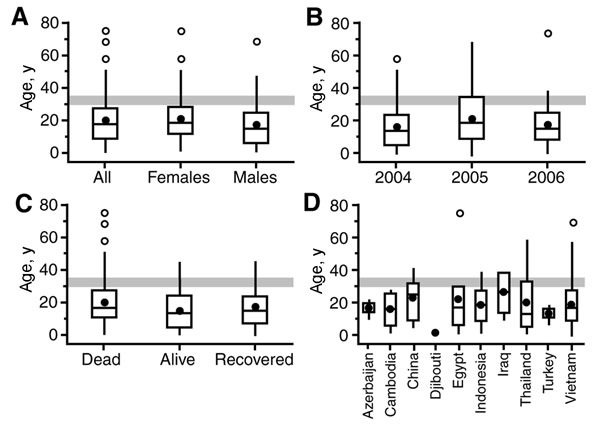Volume 13, Number 3—March 2007
Letter
Avian Influenza A (H5N1) Age Distribution in Humans
Figure

Figure. Age distribution of patients with confirmed cases of avian influenza (H5N1), December 2003–May 2006 (4,5). Box-and-whisker plots show the age distribution of patients by A) sex; B) year of report, C) patient outcome, and D) country. The horizontal line and bullet mark in each box give the median and mean age of cases, respectively. Variability in age is shown by plotting the first and third quartiles (Q1 and Q3) of the ages as the outer limits of the shaded box. Whiskers encompass all ages that satisfy the criteria Q1 – 1.5(Q3 – Q1) (lower limit) and Q3 + 1.5(Q3 – Q1) (upper limit). Points beyond the whiskers denote outliers. Panel C data are based on the recorded status of patients according to World Health Organization sources, with the category “alive” formed to include patients who were last reported as hospitalized or discharged. The age band 30–35 years is marked on each graph for reference.
References
- World Health Organization. Cumulative number of confirmed human cases of avian influenza A (H5N1) reported to WHO: 4 July 2006. Geneva: The Organization; 2006. Available from http://www.who.int/csr/disease/avian_influenza/country/en/index.html
- World Health Organization. Epidemiology of WHO-confirmed human cases of avian influenza A (H5N1) infection.Wkly Epidemiol Rec. 2006;81:249–57.PubMedGoogle Scholar
- World Health Organization. Avian influenza fact sheet (April 2006).Wkly Epidemiol Rec. 2006;81:129–36.PubMedGoogle Scholar
- World Health Organization. Situation updates–avian influenza. Geneva: The Organization; 2004–6. Available from http://www.who.int/csr/disease/avian_influenza
- World Health Organization. Avian influenza: assessing the pandemic threat. Geneva: The Organization; 2005.
- Population Division of the Department of Economic and Social Affairs of the United Nations Secretariat. World population prospects: the 2004 revision; and world urbanization prospects: the 2003 revision. New York: United Nations; 2006. Available from http://esa.un.org/unpp
- Tukey JW. Exploratory data analysis. Reading (MA): Addison-Wesley; 1977.
- Enserink M. Avian influenza: amid mayhem in Turkey, experts see new chances for research.Science. 2006;311:314–5. DOIPubMedGoogle Scholar
- Dowdle WR. Influenza A virus recycling revisited.Bull World Health Organ. 1999;77:820–8.PubMedGoogle Scholar
- Hilleman MR. Realities and enigmas of human viral influenza: pathogenesis, epidemiology and control.Vaccine. 2002;20:3068–87. DOIPubMedGoogle Scholar